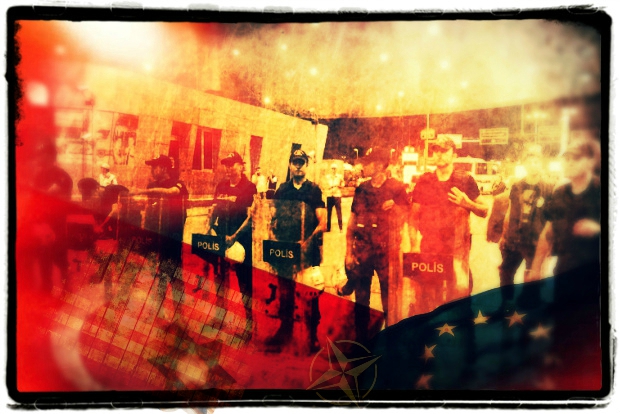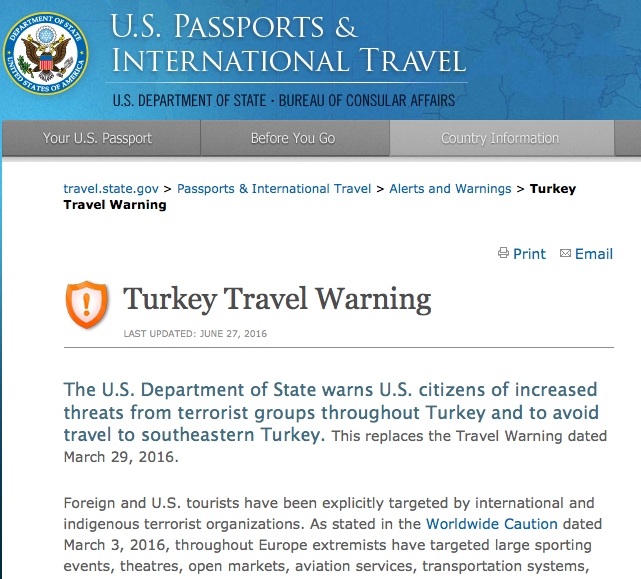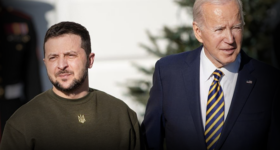Shawn Helton
21st Century Wire
Though many are still reeling in the wake of the Istanbul Attack and subsequent tragedy – key geopolitical questions have emerged following this most recent act of terror.

During the course of this article we’ll examine the available evidence of the crime itself, then make are way into the political aspects of the case.
We’ve been told the Istanbul airport attack ‘bears the hallmarks’ of an ISIS related incident, yet no official confirmation has been made…

‘UNDER SIEGE’ – Heightened security in the aftermath of the terror attack at Istanbul Atatürk Airport (Image Source: newsflash)
Terror in Turkey
According to the latest count, 44 people were killed during the recent terror attack at Istanbul’s Atatürk Airport. The heavily coordinated assault, is also said to have injured between 239-250 others, and is said to have been carried out by three suicide bombers.
As details of the attack are slowly drip-fed from various international media outlets, we’re told that authorities first exchanged gunfire with gunmen who opened fire after failing to pass through standard airport security barriers. The three men then separately detonated bombs in two different terminals, and as well as just outside an airport exit nearby a parking structure.
An unnamed senior official with the Turkish government has stated that the Istanbul airport attackers are believed to have arrived from Raqqa, Syria, about a month ago and that ‘ISIS leadership’ were involved in the terror siege at Atatürk International Airport.
Additionally, the alleged attackers believed to have taken part in the Istanbul attack are said to have come from Russia, namely Uzbekistan and Kyrgyzstan.
Prior Knowledge
Oddly, only a day prior to this major attack, the US State Dept. issues a travel warning for Turkey, citing imminent ‘terrorist’ activity.
More interesting still, in less than two days, investigators determined that the Atatürk attack was actually set in motion over one month ago, which has led some critics to suggest that intelligence officials had obtained knowledge prior to the tragic triple bombing in Istanbul.
In a news release from NBC, we’ve also learned that:
“Turkish police have arrested 13 people [allegedly] in connection with the deadly attack on Istanbul’s airport, officials said Thursday,” as “Anti-terrorism police carried out 16 raids in relation to the Ataturk attack overnight.”
According to the Turkish news agency Anadolu, the 13 suspects arrested were transferred to police headquarters, while authorities are still in pursuit of three other suspects.
It is unclear exactly how authorities have identified the alleged attack-bombers. Most press outlets are relying on Turkish reports of passports having been conveniently found at the scene.
The UK’s Mirror reports that “All three [attackers were] understood to have Russian passports in their possession, “and that “sources have also revealed its feared a second cell is about to attack imminently.”
In some ways, the Atatürk Airport attack appears to have mirrored elements of the Brussels attack that took place in late March, with evidence of a security and terror connection and a previously known cast of terrorist cells.

TERRORIST: Akhmed Chatayev (Image Source: dfwatch)
As the attack is still being pieced together, the BBC revealed that authorities had already named the organizer of the Istanbul attack:
“The organiser of the attack has been named by Turkish media as Akhmed Chatayev [labove], a Chechen believed to have acted as an IS recruiter, who is on a US counter-terror sanctions list. His fate was not immediately clear.”
Chatayev is believed to be a one-armed ‘Chechen separatist’ (a latter day Al Zarqawi) now working with ISIS, said a Turkish police source to NBC News.
Last October, the U.S. Treasury Department called Chatayev “commander of the Yarmouk Battalion,”the Chechen faction of ISIS, “that was planning attacks against U.S. and Turkish facilities.”
Question: How did authorities name the organizer of the attack so fast?
Uncloaked Mastermind, Suspects & Prior Terror Warnings
Incredibly, in less than 72 hours, investigators managed to name the organizer of the attack and knew the whereabouts of the alleged suspects whereabouts for at least a month.
Was Western intelligence tracking the group’s movements, and if so, why weren’t they stopped prior to the Istanbul attack?
To provide historical context to this latest international caper, the news agency from Republic of Georgia, Freedom & Democracy Watch published a report in October of 2015, citing that Akhmed Chatayev (nicknamed ‘Akhmed One-Arm’ by Turkish press), a Chechen with Russian citizenship, had been under the watchful eye of the United States for being affiliated with ISIS for sometime.
In fact, in December of 2012, Chatayev reportedly pledged allegiance to Abu Bakr al-Baghdadi, the purported leader of ISIS. Interestingly at the time though, Baghdadi had not formally declared the formation of ISIS until April of 2013, according to major media reports.
In the report entitled “U.S. designates Akhmed Chatayev as a terrorist,” we learn more about Chatayev’s past:
“The updated list of individuals affiliated with Islamic State of Iraq and the Levant, states that Akhmed Chatayev is currently acting in support of the terror organization which controls parts of Syria and Iraq.
The U.S. Treasury Department further writes that Chatayev is the commander of the Yarmouk Battalion, a Chechen faction of ISIL.
“In the video, Chatayev greets militants in Dagestan who in December 2012 pledged allegiance to ISIL and its leader, Abu Bakr al-Baghdadi, and says that ISIL in Syria rejoiced when it heard the news about their pledges,” the note about Chatayev reads.”
Witnesses named Chatayev as being responsible in participating in a border shooting in Lapankuri in the north of Georgia, near Chechnya and in September of 2012, he surrendered, without pleading guilty.
Also according to the report listed above, “[Chatayev] was detained in Ukraine. [Though] Russia wanted him extradited on terrorism charges, but the extradition request was rejected.”
For reasons unknown to the public, Chatayev was released by the Georgian government in 2012, even though he was said to be linked to ISIS and was being observed by US intelligence.
The article continued by stating the following regarding Chatayev’s cloaked past life:
“A Chechen, and a citizen of Russia, Akhmed Chatayev, also known as Akhmed al-Shishani, was earlier reported to have received refugee status in Austria.
After being released by Georgian authorities and after reports that he might have received asylum in Austria, a video appeared on Youtube in February, which allegedly showed him in Syria as a commander of Yarmouk Battalion, which is a Chechen faction of ISIS.”
Was Chatayev operating as an informant for the intelligence community – why was he released and why was he granted asylum in Austria for a man the United Nation’s says controls 130 militants?
RT provides some background details:
“Chataev joined Islamist secessionist militants that fought against Russia in the Second Chechen War between 1999 and 2000, where he lost an arm. Later, he was considered to be a representative of Dokka Umarov, once a “terrorist №1” in Russia, in the Western Europe.”
Continuing, it was also revealed that:
“In 2010, Chataev was arrested in Ukraine with his mobile phone files containing a demolition technique instruction and photos of people killed in a blast. Russia requested his extradition on terrorism-related charges but the European Court for Human Rights ordered Ukraine not to hand him over to Russia with Amnesty International also urging Ukrainian authorities to halt extradition as Chataev “could face an unfair trial and would be at risk of torture and other ill-treatment.”
Here we see arguable evidence of the EU obstructing justice, aided by NGO Amnesty International. Why was Chataev being protected, and by whom exactly?
Was Akhmed Chatayev really involved in this event, or has he just been injected into this story as convenient ‘celebrity terrorist’ – presented to the media a the latest “mastermind” in order to dilute any investigation (and it wouldn’t be the first time either)?
SEE ALSO: Smart Power & The Human Rights Industrial Complex
Readers should be reminded again of the ‘informant game’ we outlined in 2014 here at 21WIRE, which provided historical context to understand the intelligence community’s dicey confidential informant past:
“Human Rights Watch explains, “The 214-page report, “Illusion of Justice: Human Rights Abuses in US Terrorism Prosecutions,”examines 27 federal terrorism cases from initiation of the investigations to sentencing and post-conviction conditions of confinement. It documents the significant human cost of certain counter-terrorism practices, such as overly aggressive sting operations and unnecessarily restrictive conditions of confinement.”
The list of terror informants and puppets is as long as it is colorful, starting with the infamous ‘Underwear Bomber’, who was allowed to travel to the US without a passport and was accompanied by an intelligence agent on his flight from Amsterdam to Detroit.
Who can forget the FBI’s ill-fated 1993 World Trade Center bombing attempt, where FBI handlers trained the driver and gave them explosives – and worst of all – stood by and watched as their sting subjects went ahead and detonated their concoction underneath the world’s tallest building in New York City.”
Incidentally, after the 1993 WTC attack, the FBI was said to have tried to ‘lure’ Emad A. Salem (role player in WTC bombing), a former Egyptian army officer who was a prized undercover operative back into a role as a confidential informant, with agents suggesting he should go into the Witness Protection Program.
The Istanbul Attack may be similar to other high profile incidents such as the Brussels airport attack, the Orlando nightclub shooting, the San Bernardino shooting and the Paris attacks of 2015 – which have all been used to distort public opinion, while very often pushing the populace to accept new security measures in the wake of heavily stylized mass-tragedies.
Will this also be the case following the Istanbul attack?

Over the past 24 hours, authorities have released a CCTV still image depicting the alleged Istanbul attackers (See image above via twitter), which has prompted some larger media outlets to focus on the emotional drama of the terror siege (the ‘smiling’ suspects), rather than concern over the facts and connections observed in the Istanbul attack itself.
This post attack CCTV-based ID narrative is practically identical to that of the Brussels Attack earlier in the year, and also similar to London 7/7 post event narrative.
Additionally, authorities have also revealed the apparent identity of two of the attackers, with the following information comes from Turkey’s state run media arm Anadolu, as relayed by USA Today:
“The state-run Anadolu Agency reported Friday that the Bakirkoy Public Prosecutor’s office established the identity of two of the suspects as foreign nationals Rakim Bulgarov and Vadim Osmanov. Officials are still trying to determine the name of the third killer.
Osmanov was identified from a passport photocopy given to a property agent in Istanbul’s Fatih district, the Daily Sabah newspaper reported.
Authorities imposed a temporary news blackout within Turkey on Friday on information concerning the investigation, the Associated Press reported.”
It has become somewhat commonplace for Turkey to issue a temporary news blackout in recent years. Such a move only prompts more questions following any major event, with retaining more governmental control over information released.
All of the latest developments concerning the incident at Istanbul’s main airport come after it was revealed that the US State Department reissued a travel warning for Turkey just 24 hours before the attack.
21WIRE contributor and researcher, Vanessa Beeley recently discussed the recent airport attack in Istanbul, it’s shaky storyline and the need to watch parallel media reports:
“The United States and Turkey seem to be holding back on deciding which way the propaganda should go, not confirming that it is ISIS gives them the possibility to perhaps take the narrative in the direction of Erdogan’s arch enemy, the Kurds.
John Brennan, CIA director has been quoted as saying that the attack bears the hallmark of “ISIS depravity” but he is being uncharacteristically slow in igniting that particular fuse. Anonymous US sources have stated that US Intelligence does not have enough evidence to indicate ISIS involvement but also say that perhaps Turkey has evidence they are not aware of. This is a very unfamiliar ambiguity from both countries which may suggest they are not sure which way to run the storyline.”
Question: What exactly did US authorities know about upcoming threats related to Turkey?
Presumably, US officials were still tracking the Istanbul attack organizer Chatayev, after he was placed on a US Treasury sanctions (as mentioned above) list in 2015?
The report clearly indicates that “as of mid-2015, Chatayev was a member of ISIL and was part of a group of militants that was planning attacks against U.S. and Turkish facilities.”
Are we witness to yet another intelligence failure by the West in the wake of a terror – how many more times will this old narrative play itself out to the public?
Continuing, Beeley outlines the need to pay attention to overlapping stories after a major global incident, “we should also always connect to other events running in parallel such as the release of the Republican’s Benghazi Report.”
Over the past day, as “Turkey continued the investigation into the triple suicide bombings that killed 44 people at Istanbul’s main airport, security forces killed the mastermind of a previous attack in the country’s capital, according to media reports.”
The security force operation killed Mehmet Sirin Kocakaya (aka Sirin) a man said to be responsible for the Kurdistan Worker’s Party (PKK) bombing which took place in Ankara on Feb. 17th, which killed 29 people.
In the aftermath of one attack, sometimes an older terror loop is seemingly closed out or in this case ‘terminated’ while there is still confusion surrounding the most recent terror event. Is this misdirection or are both events related somehow?

‘SHOCK AND AWE’ – The chaotic aftermath outside Istanbul Atatürk Airport. (Image Source: indianexpress)
Turkey Going Gladio?
In a recent NBC report, “… the deadly bombings at a Turkish airport could be the start of a new wave of terror attacks, worried U.S officials, ” adding that “Our long summer of discontent has just begun,” according to an unnamed senior intelligence official.
What do intelligence agencies know about any upcoming world wide attack plans?
In December of 2015, in a 21WIRE article entitled “GLADIO GOES GLOBAL: Gangs and Counter Gangs in Europe, Northern Ireland, Iraq and now in Syria,” we see a dark alliance between security operations and terror events across Europe as familiar patterns start to emerge:
“In addition to the French, Belgium and Italian branches of Operation GLADIO, there is also the rarely mentioned British contingent – GLADIO’s key component, which seems to be international in scope – bringing GLADIO into a global context.”
In a 2007 article by Nafeez Ahmed, entitled “The Strategy of Tension,” we discover the existence of many stay-behind operations under the Gladio umbrella setup by the CIA and other Western intelligence agencies:
“The existence of this secret operation exploded into public controversy when in August 1990 upon the admissions in parliament by Italian Prime Minister Giulio Andreotti, the existence of ‘Gladio’ was exposed as a secret sub-section of Italian military-intelligence services, responsible for domestic bombings blamed on Italian Communists.”
ZeroHedge, recently questioned the nature of many recent terror plots in Turkey, suspecting false flag terrorism, referencing certain Gladio-style operations, that have applied political pressure in the form of controlled and manufactured terror events.
To provide further background on the existence of state-sponsored terror using proxy agents, here’s a link to a recent 21WIRE post concerning a BBC documentary entitled, “Operation Gladio.” It describes how a secret army operated by the CIA and MI6 via NATO was used to carryout worldwide political objectives through a “strategy of tension.”
In a 21WIRE report regarding 2015’s summertime triple terror events in France, Tunisia and Kuwait, we discussed the curious connection between security and terror:
“In an article published at Global Research written by Andrew Gavin Marshall, entitled “State-Sponsored Terror: British and American Black Ops in Iraq,” we see the historical outline and correlation between security agencies and the terror that’s never too far behind:
In January of 2002, the Washington Post ran a story detailing a CIA plan put forward to President Bush shortly after 9/11 by CIA Director George Tenet titled, “Worldwide Attack Matrix,” which was “outlining a clandestine anti-terror campaign in 80 countries around the world. What he was ready to propose represented a striking and risky departure for U.S. policy and would give the CIA the broadest and most lethal authority in its history.”
As the article continues, we see the growing power of clandestine intelligence agencies and their direct involvement in so-called ‘terrorist’ incidents, most notably with the CIA since 9/11:
“the creation of a super-Intelligence Support Activity, an organization it dubs the Proactive, Preemptive Operations Group (P2OG), to bring together CIA and military covert action, information warfare, intelligence and cover and deception.
The Global Research treasure trove also included a Telegraph news release from February 5, 2007:
“Deep inside the heart of the “Green Zone” [in Iraq], the heavily fortified administrative compound in Baghdad, lies one of the most carefully guarded secrets of the war in Iraq. It is a cell from a small and anonymous British Army unit that goes by the deliberately meaningless name of the Joint Support Group (JSG).”
It turns out that the JSG, also operated under the cover moniker, Force Research Unit (FRU) “which between the early 1980s and the late 1990s managed to penetrate the very heart of the IRA.”
“The FRU turned and blackmailed members of the IRA to work for the paramilitary organization as double agents. All told, the FRU/JSG was able to establish control at the highest levels of the IRA. The unit was renamed in the aftermath of Stevens Inquiry, which investigated allegations of a collusion between the security forces and protestant paramilitary groups:
“The Stevens Inquiry’s report “contains devastating confirmation that intelligence officers of the British police and the military actively helped Protestant guerillas to identify and kill Catholic activists in Northern Ireland during the 1980s.”
Former British intelligence agent, Kevin Fulton, who also worked with the FRU, stated that knowledge of the orchestrated unit was known by high level officials, claiming they had been ‘sanctioned’ by former PM Margaret Thatcher.”
Are the recent terror events linked to parts of Europe and now Turkey evidence of modern Gladio operations?
Below we’ve linked to an engaging and insightful interview with author Daniele Ganser, who has painstakingly documented the terror activities of security services through operation GLADIO in his book, “NATO’s Secret Armies: Operation Gladio and Terrorism in Western Europe.”
Watch Ganser examine the historical evidence of ‘stay-behind’ armies that appear to mirror much of the terror atrocities occurring today…

‘ROGUE STATE’ – Turkish Prime Minister Recep Tayyip Erdogan (Image Source:rinf)
Bad Actors & Security failures
Turkey is no stranger to harboring various groups of fighters, by influencing groups found to be tied to the formation of ISIS. It should also be noted that Turkey was very supportive of its NATO colleagues that were seeking to attack Syria, a strategy which fit snugly with the policy planning of the US-Israel-GCC alliance.
In 2015 Reuters news agency reported that, “… according to a prosecutor and witness testimony from Turkish Gendarmerie officers, “Turkey’s state intelligence agency helped deliver arms to parts of Syria under Islamist rebel control during late 2013 and early 2014.”
Yet despite the formal court room declaration, “Ankara has denied arming Syria’s rebels or assisting hardline Islamists. Diplomats and Turkish officials say it has in recent months imposed tighter controls on its borders.”
However, revealing: “testimony from gendarmerie officers in court documents reviewed by Reuters allege that rocket parts, ammunition and semi-finished mortar shells were carried in trucks accompanied by state intelligence agency (MIT) officials more than a year ago to parts of Syria under Islamist control.”
According to Israeli intelligence, back in 2012, Turkey was said to have replaced Iran, as a Hamas’ top financial backer.
In 21WIRE‘s 2016 predictions, there was an outline of some of Turkey’s most egregious foreign policy decisions in recent history, such as facilitating an open flow of terrorist fighters, weapons, cash, in addition to being implicated in a high stakes oil trade with ISIS on the black market. And in late 2015, a Lebanese citizen was arrested in Kuwait along with other suspects, who apparently purchased arms in Ukraine meant to be delivered to militants in Syria through smuggling routes located in Turkey.
So why exactly would ISIS target Turkey, a rogue state that appears to have aided the rise of ISIS and Al Nusra Front and other terrorist groups inside Syria, ostensibly fomenting terror throughout parts of the Middle East? Could it be that ISIS operations are controlled by external international bodies?
For those still doubtful, consider the following…
As Turkey has become a hotbed of terror related activity over the past few years, there have also been suspicious security failures during terror events. The attack on Istanbul’s Atatürk Airport appears to be no exception, as the Israeli security services firm ICTS is once again front and center regarding a terror plot involving their screening failures, such as Umar Farouk Abdulmutallab the so-called ‘underwear bomber’ in 2009, as well as ‘shoe bomber’ Richard Reid in 2001, and more recently the twin bombing at Brussels main airport.
The aviation and general security services firm ICTS, reportedly handles security at a number of places world wide including Brussels and Turkey.
We’ve previously documented the link between mass casualty drills occurring prior to a terror related events, including the Brussels attack in March of 2015:
Back in 2013, it was a “… full-scale emergency drill at Brussels Airport to test and evaluate the preparedness of our airport emergency services in the event of an incident.”
Here’s a YouTube video depicting the Brussels Airport drill in April of 2013, and then again in April of 2015…
Was this latest security lapse at Atatürk Airport just a coincidence, or was there something else at work in Istanbul?
Turkey’s Fallout, Brexit Pressure & Framing Russia
Due to Turkey’s role in the migrant crisis over the past year and it’s facilitator role with al Nusra, ISIS and other terrorists groups, through various weapons shipments and black market oil trade – as well as the much debated EU membership, renegotiation visa-free travel and Brexit vote outcome – is it possible that Turkey may have been punished Gladio-style?
It should be noted here, that at the same time this terror attack took place, both Russian and Turkish delegation were scheduled to meet in what many believe was a positive step toward détente following icing relations for the last 8 months after Turkey shot down a Russia Fighter Jet along the Syrian-Turkish border in November 2015. With the alleged suicode bombers being identified as “Russian”, it doesn’t take much to see how this event could be used to disrupt diplomacy and cast doubt the prospects for renewed success in the area Russian-Turkish relations. This brand of geopolitical manipulation was a staple of the Operation Gladio modus operandi.
With speculation aside, there are multiple overlapping narratives coming out of Istanbul, at least in part, Western news agencies have pounced on this latest crisis by attempting rather incredulously to lay blame in the direction of Russia – even though Russia wanted the apparent ‘Istanbul mastermind’ behind bars. This kind of propaganda is also reminiscent of how Assad was erroneously blamed for the influx of terror in Syria the past five years.
Note the narrative in this passage from the UK’s Express:
“Tensions are rising once more between the leaders of Russia and Turkey, just one day after they spoke for the first time since the downing of a Russian military jet.
When they met, Turkey apologised for the shooting down of a Russian war plane last year.
However, one day after, Turkish officials have said that the Istanbul airport suicide attackers were from Russia, Uzbekistan and Kyrgyzstan.”
So given the case we’ve outlined so far, who do you think benefits the most from the Istanbul Attack?
Support our work and Become a Member @ 21WIRE.TV
READ MORE ISTANBUL ATTACK NEWS AT: 21st Century Wire Istanbul Files
















